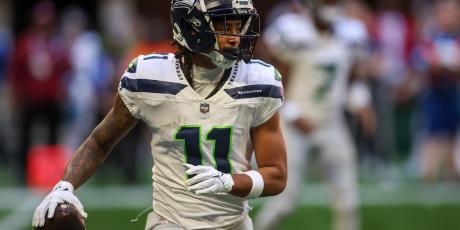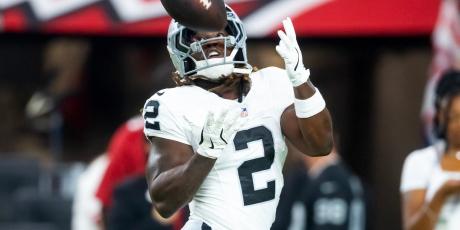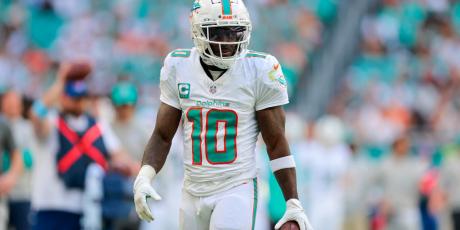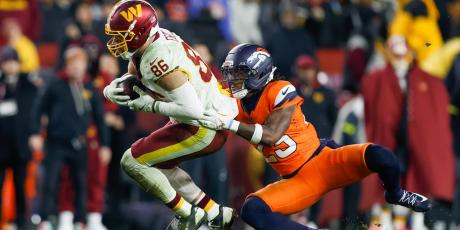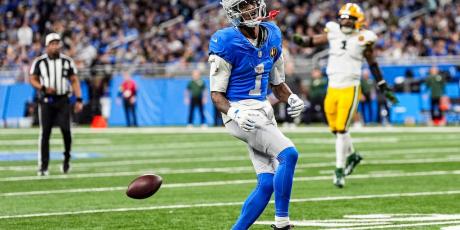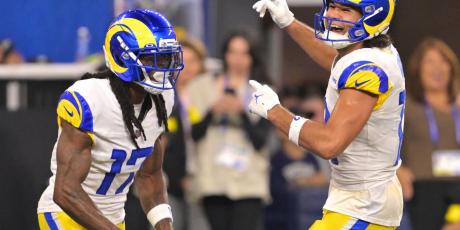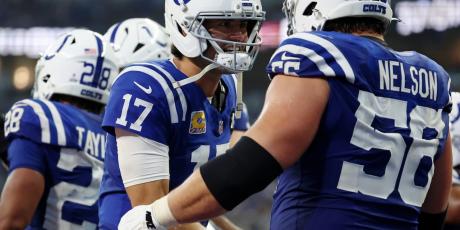Is There a Running Back Value in Cleveland?
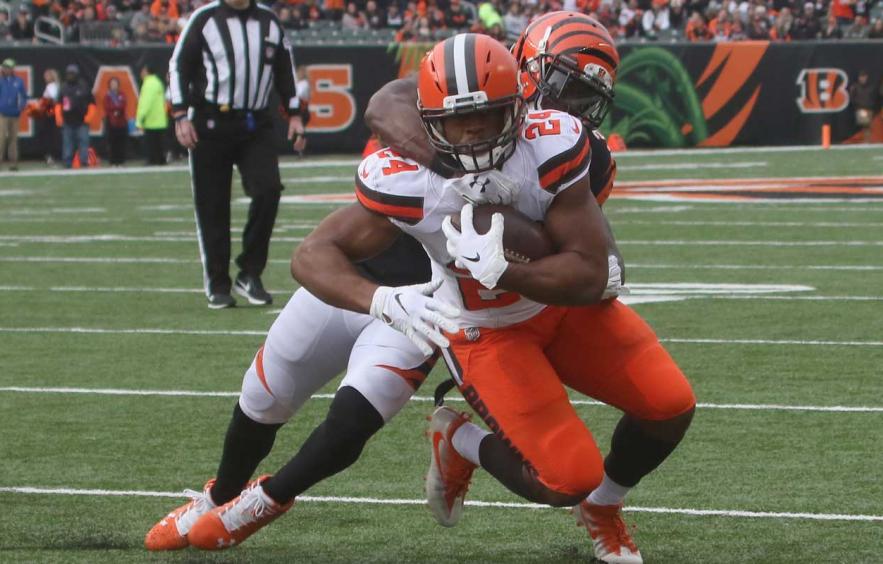
On the opening day of free agency, the Cleveland Browns signed Carlos Hyde to a three-year, $15 million contract. It was supposedly a signing intended to replace Isaiah Crowell. Just weeks later, though, Cleveland selected Georgia running back Nick Chubb with the 35th overall selection. Eliot Crist has already advised against drafting Chubb this year, but the fantasy community is high on the crowded Browns backfield—4for4’s Multi-Site ADP shows all three Cleveland backs being drafted within the top 37 at their position and post-NFL draft MFL10 ADP has all three in the top 34.
Editor's Note: Find all our 2018 Player Profiles here.
The following will take a look at how Chubb, Hyde, and Duke Johnson fit into the Browns’ backfield plans and discuss whether there is any fantasy value to be had from this three-headed running back monster.
Todd Haley Takes Over in Cleveland
Browns head coach Hue Jackson has traditionally run one of the most run-heavy offenses in the league, when adjusted for game script, and he’s done so largely with a committee approach throughout his play-calling career. This offseason, Cleveland signed OC Todd Haley, who slants much more towards the pass than Jackson, and Haley is expected to have “total autonomy” of the offense.
| Year | Team | Overall Rush% | Rank | Neutral Rush%* | Rank | Team RB Touches | Rank | RB Targets | Rank |
|---|---|---|---|---|---|---|---|---|---|
| 2007 | Cardinals | 39.8% | 29 | 39.7% | 25 | 430 | 27 | 105 | 16 |
| 2008 | Cardinals | 34.8% | 32 | 36.3% | 32 | 387 | 29 | 118 | 7 |
| 2009 | Chiefs | 44.0% | 17 | 42.3% | 14 | 452 | 19 | 108 | 13 |
| 2010 | Chiefs | 53.7% | 1 | 53.3% | 1 | 608 | 1 | 141 | 3 |
| 2011 | Chiefs | 48.9% | 7 | 55.7% | 2 | 519 | 4 | 113 | 13 |
| 2012 | Steelers | 41.8% | 21 | 38.9% | 21 | 450 | 14 | 111 | 9 |
| 2013 | Steelers | 39.9% | 25 | 39.2% | 21 | 429 | 21 | 108 | 16 |
| 2014 | Steelers | 40.5% | 22 | 39.6% | 22 | 476 | 9 | 129 | 7 |
| 2015 | Steelers | 39.8% | 21 | 35.5% | 29 | 405 | 25 | 79 | 30 |
| 2016 | Steelers | 40.7% | 20 | 38.6% | 21 | 472 | 6 | 124 | 6 |
| 2017 | Steelers | 42.5% | 20 | 39.9% | 27 | 477 | 8 | 109 | 18 |
*Neutral game script is when the score is within seven points.
Whether adjusted for game script or not, Haley’s offenses have consistently ranked outside the top 20 in rushing rate but his backfields’ touch totals have been boosted because of usage in the passing game. While there seems to be a clear trend here, Haley’s usage rates are also skewed by a group of Hall of Fame-caliber players. Every year that Haley ranked outside the top 20 in rushing rate, he had either Kurt Warner or Ben Roethlisberger under center; the seasons where Haley’s offenses ranked in the top 10 in running back touches were years with a healthy Jamaal Charles or LeVeon Bell.
The season that most closely resembles the roster that Haley will inherit in Cleveland, especially the backfield, is the 2011 Chiefs. Without a clear-cut workhorse and two backs essentially filling the same role, Haley led an offense that saw three running backs receive a backfield touch share above 30 percent, the only such occurrence over the last 10 seasons.
| Player | G | RuAtt | RuYds | RuTD | Targ | Rec | RecYds | RecTD | PPR | Touches | Team RB Tchs | Touch % |
|---|---|---|---|---|---|---|---|---|---|---|---|---|
| Dexter McCluster | 16 | 112 | 507 | 1 | 65 | 47 | 334 | 1 | 143.1 | 159 | 519 | 30.6% |
| Jackie Battle | 15 | 148 | 598 | 2 | 13 | 9 | 68 | 0 | 87.6 | 157 | 519 | 30.3% |
| Thomas Jones | 16 | 152 | 478 | 0 | 7 | 5 | 43 | 0 | 57.1 | 157 | 519 | 30.3% |
Considering Haley’s coaching record combined with Jackson’s history, it’s reasonable to assume that Chubb and Hyde will tag team the Crowell role in this offense, while Johnson will maintain a significant portion of passing-down work.
Carlos Hyde Versus Nick Chubb
Hyde has averaged roughly 18 touches per game in each of his last three seasons in San Francisco. While 2017 was his best season from a fantasy production standpoint, Hyde fell off as a runner. Last year marked the first season where he posted a negative rushing DVOA (min. 100 carries), bested by 35 other backs in per-play value versus the average. Although Chubb is arguably the most talented pure runner in the 2018 draft class, Hyde’s ability to catch the ball will force him into more snaps than Chubb.
While Chubb amassed just 31 receptions in 47 college games, Hyde has seen his usage in the passing game steadily grow since entering the league, peaking at 88 targets last season. The Browns are much improved on paper over their 2017 iteration but Vegas still projects Cleveland for just 5.5 wins, the lowest expected win total in the league. Game flow is especially important in Cleveland as Jackson and Haley have proven to be two of the most game-script-sensitive coaches in the league, reacting especially strongly to negative game script—as a play caller, Haley has run just 28 percent of the time when down by more than a touchdown and 35.6 percent of the time in losses, both marks that come in below the league average. Even as the inferior runner, expect Hyde to out-snap Chubb in 2018.
Duke Johnson, Pass-Catching Extraordinaire
While game flow figures to push Hyde into a larger workload than Chubb in 2018, passing situations will dictate a three-man running back committee because of Johnson’s presence. Since entering the league in 2015, Johnson hasn’t seen fewer than 74 targets in a season and 42 percent of his touches have come via the pass, the fifth-highest mark among running backs with at least 200 touches in that span. In addition to high-target volume, Johnson has been one of the most efficient pass-catching backs in the league—his 7.22 yards per target ranks sixth among running backs with at least 50 targets since the beginning of 2015. A recent three-year extension showed that the Browns value this role.
All of this isn’t to say that Johnson is a one-trick pony. Johnson didn’t meet the required 100 carries to qualify for rushing DVOA in either of the last two seasons but his per-carry value against the average would have ranked third among all backs last year and 12th in 2016. There won’t be many rushing opportunities for Johnson in 2018, but when he is handed the ball he’s proven to be effective.
Because Hyde is a capable pass-catcher himself, don’t expect Johnson to approach the 53 percent snap share that he saw last season. On a team that will be forced to throw more often than not, Johnson has as good of a shot as any of these three backs to lead the team in snaps.
Bottom Line
The fact that there are three running backs on one team being drafted as RB3s or better speaks to the fact that there are still major inefficiencies to be exploited in fantasy football. Understand this: None of these running backs should be drafted at their current asking price. Remember, though, that ADP is simply an average—per MFL10 ADP, each of these backs has fallen outside of the top 100 at some point since the NFL draft. Because the Browns figure to be in passing situations more often than not, Duke Johnson can still be a valuable buy when he does slip in drafts. We already know that a running back reception is roughly four times more valuable than a carry in PPR leagues and that’s where Johnson excels. Since Chubb and Hyde figure to split early-down work, Johnson has an outside chance to see the field more than either of his backfield mates and he happens to be the cheapest player of the bunch, despite being the highest paid.
Photo by John Grieshop/Getty Images.
Related Articles

